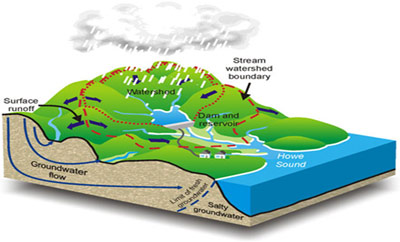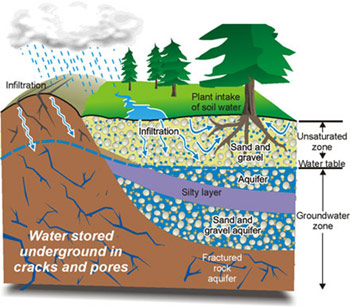Watersheds and Aquifers 101
 When rain falls on the ground, some of it travels slowly down through the ground to the aquifer. As water makes its slow journey, it is filtered by soil, sand and gravel. This water is called groundwater.
When rain falls on the ground, some of it travels slowly down through the ground to the aquifer. As water makes its slow journey, it is filtered by soil, sand and gravel. This water is called groundwater.
Some of the rainwater runs over the land into lakes, rivers, and streams. This water is called surface water.
What is a Watershed?
A watershed is an area of land that catches rain and snow and where water flows downward into a specific river, stream, lake, or aquifer. All land is part of a watershed and we all live in a watershed.
 Think about your local creek, river, or stream. Where does it come from? What type of landscapes does it pass through? All of the area covered is a watershed. What happens on the land affects the water in the ground as well as the local creeks, river, streams, and the fish that live in them.
Think about your local creek, river, or stream. Where does it come from? What type of landscapes does it pass through? All of the area covered is a watershed. What happens on the land affects the water in the ground as well as the local creeks, river, streams, and the fish that live in them.
What is an Aquifer?
An aquifer is the area underground where spaces between gravel, sand, clay, or rock fill with water. Water stored underground is called groundwater. There are different types of aquifers. When water is found in cracks and pores in the rock, we call this a 'bedrock' aquifer. When water is found in the spaces between sand and gravel, we call this a 'sand and gravel', or 'unconsolidated' aquifer. The RDN has both types of aquifers. See RDN Water Regions, click on an area and then select "Aquifers" for more information.